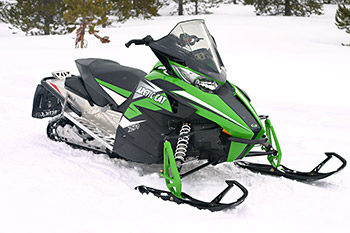Arctic Cat has been making noises it wants to compete more in markets where small 4-strokes rule.
This is primarily the utility market and if you look at what Polaris has done the last two years with its very successful utility-targeted Indy line-up you can see how much potential there is. However, there’s also a decent market for lower-cost entry-level trail-focused iron with short-tracks and conservative weight.
True, since Polaris doesn’t offer any 4-stroke engines in its snowmobiles, nearly all those utility and entry-level Polarii are powered by the company’s fan-cooled 550cc 2-stroke.
Meanwhile, Ski-Doo sells a ton of utility sleds powered by its 600cc ACE twin. That small-displacement 4-stroke’s selling points are ease-of-use, fuel economy and rock-solid reliability. Interestingly, consumers are willing to pay considerably more for those benefits.
So where does this leave Arctic Cat? The company’s Lynx 2000 series, using the elderly Twin Spar platform is a stop-gap answer to this market but probably isn’t the kind of sled Cat would like to invest zillions into basing a bunch of new models on in the above categories going forward. Weight and manufacturing complexity are definitely issues and a successful offering here would pretty much need to be a fresh sheet of paper.
It seems pretty clear an entry level trail model would need to have a lighter 120-inch skidframe and track, the utility sleds a 141 or 144-incher. Cat already has good technology with its Sliding Front Arm suspension and its super-light XF skidframe. Both would certainly be adaptable to a new chassis.
Cat could bypass a lot of start-up and tooling costs by just building a simplified version of the ProCross using a shorter 120-inch version with a lightweight, small displacement Yamaha mill under the hood.
If you’re thinking the current Phazer 500 4-stroke, it probably wouldn’t be a choice for a low cost substitute because it’s extreme performance level (80-hp from a 500cc twin) makes it a very pricey engine to build and would make the concept of a cheap 4-stroke difficult to deliver on.
To our knowledge, Yamaha doesn’t have a lower cost substitute engine on its menu right now. We’d be willing to bet both Cat and Yamaha are working on one, though.




